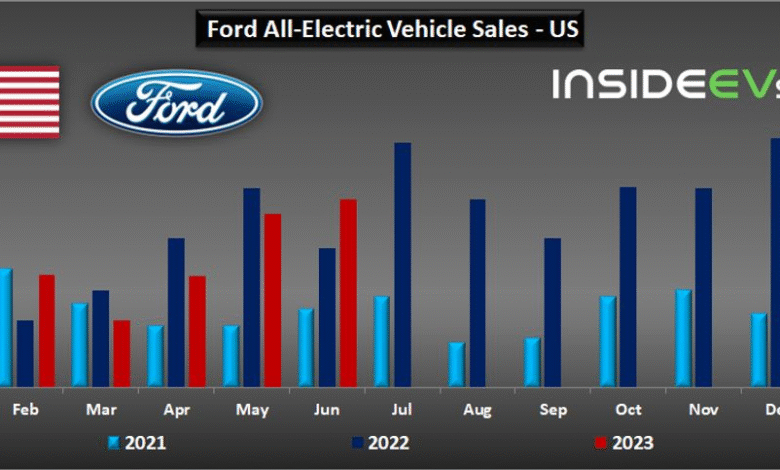Ford U.S. Sales Increase: 16.3% Rise Reported in May

Ford U.S. sales increase reflects a significant turning point for the automaker, showcasing a remarkable 16.3% rise year-over-year in May 2024. This surge in sales can be attributed to the ongoing employee pricing program, which continues to attract consumers amidst the challenges of rising tariffs and vehicle price increases. Notably, sales of traditional internal combustion engines saw a 17.2% boost, while hybrid vehicle sales soared by nearly 29%. Despite a decline in all-electric vehicle sales, particularly the electric F-150, Ford’s overall sales performance demonstrates strong demand within the automotive market. As the company navigates the complexities of the current economic landscape, particularly with the recent price adjustments, they are clearly committed to delivering value and innovation to their customers.
In May 2024, Ford reported a substantial growth in automotive sales across the United States, marking a key milestone for the brand. This uptick in sales comes as Ford implements attractive pricing strategies designed to enhance consumer engagement, including a special employee pricing initiative. The standout performers in this sales rise were conventional gas-powered vehicles, alongside a remarkable spike in hybrid model purchases. Although the fully electric vehicle segment faced challenges, Ford’s strategic adjustments—the introduction of elevated pricing on certain models after May 2—aim to enhance profitability while maintaining customer interest. As the automotive landscape evolves, Ford’s aggressive sales tactics and innovative offerings position the company for continued success in an increasingly competitive market.
Ford U.S. Sales Increase: A Significant 16.3% Growth
Ford Motor Company has reported an impressive 16.3% year-over-year increase in U.S. sales for May 2024. This surge is primarily fueled by strong demand for vehicles equipped with traditional internal combustion engines, which saw a remarkable 17.2% rise in sales. The automaker’s success in the market can be attributed to various factors, including the continuation of its employee pricing program, which not only enhances affordability for consumers but also drives customer loyalty. With the added selling day in May, this growth trajectory is likely to maintain momentum into the coming months.
Additionally, the growth in sales reflects Ford’s strategic response to ongoing external pressures, such as rising tariff costs. Although the automaker did have to implement some price increases, particularly for vehicles built overseas, the intrinsic value of Ford’s offerings remains strong. The combination of robust sales figures and price strategies continues to position Ford favorably in the competitive automotive landscape, as they cater to consumer demands while navigating complex economic challenges.
Employee Pricing Program: A Boost to Sales
The employee pricing program initiated by Ford has been a game changer in sustaining their sales growth. By providing consumers with attractive pricing options during a period marked by uncertainty due to tariffs, Ford has successfully attracted buyers looking for reliable and budget-friendly vehicles. This initiative not only resonates well with customers but also showcases Ford’s commitment to making vehicles more accessible in a rising price environment. As the program is set to extend through the Fourth of July weekend, it is expected to continue driving sales volumes in the face of challenging market conditions.
Ford’s emphasis on the ‘From America, For America’ tagline, particularly in their employee pricing program, enhances their brand appeal and fosters a sense of community among buyers. This approach not only solidifies consumer trust but also aligns with growing trends favoring domestic manufacturing. With sales driven by this initiative, along with solid performance in hybrid vehicle categories, Ford is poised to capture a larger market share despite fluctuations in the automotive industry.
Internal Combustion Engine Sales: A Continued Stronghold
Internal combustion engine (ICE) vehicles remain a cornerstone of Ford’s sales strategy, particularly highlighted by the 17.2% increase in sales for these models in May. This figure underscores a significant consumer preference for traditional vehicles amidst the increasing popularity of alternative fuel options. While many companies are pivoting towards electric and hybrid models, Ford’s solid ICE sales indicate a sustained demand which the company is keen to leverage, ensuring they remain competitive in every segment of the market.
Furthermore, the success of Ford’s internal combustion engines amid evolving consumer preferences can largely be attributed to their reliability and performance. Models like the Ford F-Series continue to dominate the market, as buyers seek trusted and powerful vehicles for both personal and professional use. This emphasis on internal combustion engine sales is essential for the company as it navigates a transitional automotive landscape marked by changing regulations and consumer behavior.
Hybrids on the Rise: A 29% Surge in Sales
Ford has experienced a remarkable 29% increase in hybrid vehicle sales, indicating a shift in consumer habits towards more fuel-efficient options. This surge highlights the growing awareness of environmental concerns and the desire for more economical choices among consumers, especially in a climate of rising fuel prices. The success of hybrid models showcases Ford’s commitment to innovation and sustainability, fulfilling a crucial demand in the market.
Moreover, the rise in hybrid vehicle sales complements Ford’s overall strategy to diversify its lineup. By investing in hybrid technology and promoting these vehicles alongside traditional models, Ford is strategically positioning itself to capture a wider audience. This shift not only enhances their brand reputation as a forward-thinking automaker but also allows them to remain competitive as more consumers lean towards eco-friendly alternatives.
Challenges in the Electric Vehicle Market
Despite the overall growth in sales, Ford has faced challenges in its electric vehicle (EV) segment, reporting a 25% decline in sales for its all-electric models, particularly the popular electric F-150. This dip in demand reflects broader market conditions and consumer hesitance amid high prices and limited infrastructure, especially in areas where charging stations are not yet prevalent. Ford recognizes the importance of addressing these challenges to sustain overall growth and consumer interest in their electric offerings.
To counteract these setbacks, Ford is likely to ramp up its efforts in both marketing and infrastructure development for electric vehicles. As the industry moves towards electrification, Ford will need to enhance its EV features while also investing in partnerships to improve charging accessibility. By focusing on these areas, the automaker can work to reclaim its market position and drive renewed interest in electric models.
Navigating Price Increases and Tariff Impacts
Ford’s strategy also includes addressing the price increases brought about by tariffs, particularly those affecting imported vehicles from Mexico. The decision to raise prices on certain models has been a necessary response to the financial pressures imposed by changing tariff policies. Customers are understandably concerned about these hikes, and Ford’s communications about the reasons behind them will be crucial in maintaining consumer trust and loyalty.
As the automotive landscape evolves, ensuring transparency around pricing will be vital for Ford. By managing customer expectations effectively and providing insights into the cost implications of tariffs, the company can foster a better understanding among buyers. Addressing these price adjustments head-on will also demonstrate Ford’s commitment to customer satisfaction, which can mitigate any potential backlash from price-sensitive consumers.
Cox Automotive’s Forecast: A Balancing Act
Cox Automotive’s predictions indicate a slight slowdown in the U.S. sales pace for May compared to prior months, emphasizing the importance of maintaining a sustainable growth rate amidst fluctuating market dynamics. While the forecasted seasonally adjusted annual rate (SAAR) reflects a minor increase from last year, it also signals that the recent surge in buying driven by tariff concerns may lead to more tempered sales indicative of market normalcy.
In this landscape, Ford’s ability to adapt to changing forecasts and consumer behaviors will be paramount. Maintaining a competitive edge will require constant evaluation of sales strategies and inventory management, ensuring that Ford remains responsive to market fluctuations. By balancing consumer demand with production capabilities, Ford can not only meet the volume expected but also sustain the quality that has been pivotal in their renowned brand reputation.
Strategic Insights for Future Growth
As Ford navigates the complexities of the modern automotive environment, strategic insights into consumer trends and technological advancements will be key to its success. Focusing on hybrid and internal combustion models while also investing in electric vehicle development allows Ford to cater to a broad range of consumer preferences. This dual approach not only enhances their market resilience but also positions Ford as a leader in automotive innovation.
Looking ahead, continued investment in research and development, along with strong marketing initiatives for their growing hybrid and EV portfolios, will be essential. By keeping pace with industry advancements and understanding customer needs, Ford can ensure long-term growth focused on sustainability and performance, ultimately shaping the future of mobility and transportation.
The Road Ahead for Ford Motor Company
The forward path for Ford Motor Company is paved with opportunities, with a robust strategy that integrates customer feedback, market analysis, and product innovation. By focusing on robust sales of internal combustion and hybrid vehicles, Ford can continue to generate significant revenue while adapting to anticipated shifts towards electrification. The emphasis on employee pricing programs and consumer engagement further solidifies their market positioning, reinforcing the brand’s commitment to American manufacturing.
As Ford advances, attention to emerging technologies and consumer preferences will be critical. With plans to enhance its EV offerings and tackle the challenges posed by market fluctuations, Ford is well on its way to amplifying its impact on the automotive industry. By consistently aligning with customer needs and preferences, Ford Motor Company is poised to thrive in a dynamic market landscape.
Frequently Asked Questions
What factors contributed to the Ford U.S. sales increase in May 2024?
The Ford U.S. sales increase in May 2024 can be attributed to several key factors, including a robust 17.2% increase in traditional internal combustion engine sales and a remarkable 29% rise in hybrid vehicle sales. This growth was further supported by Ford’s employee pricing program, which has resonated well with customers amid rising tariff costs and vehicle price increases.
How does the employee pricing program affect Ford sales in the U.S.?
Ford’s employee pricing program has significantly contributed to the company’s U.S. sales increase. Launched in response to President Trump’s tariffs on imported vehicles, this program has made Ford vehicles more financially attractive to customers, driving a reported 16.3% year-over-year increase in May 2024 sales.
What impact did tariff increases have on Ford’s U.S. sales in May 2024?
The tariffs imposed by President Trump, specifically the 25% on imported vehicles, led to strategic shifts in pricing and consumer behavior. While these tariffs contributed to overall price increases for certain Ford models, they also spurred consumer urgency to purchase vehicles beforehand, resulting in a significant boost in Ford U.S. sales during May 2024.
Why did Ford experience a decline in electric vehicle sales despite overall U.S. sales increase?
Despite the overall Ford U.S. sales increase in May 2024, the automaker faced a 25% drop in electric vehicle sales, particularly for its electric F-150 model. This decline contrasts with strong sales of traditional and hybrid models, indicating shifting consumer preferences and potential market challenges for electric vehicles amidst the increasing popularity of internal combustion and hybrid options.
What are the expectations for Ford U.S. sales trends moving forward?
While Ford has experienced a significant U.S. sales increase in May 2024, industry forecasts suggest that the pace may slow down in the coming months. Following a surge due to tariff-induced buying, projections by Cox Automotive indicate that the sales rate may stabilize around 16 million vehicles annually, potentially lower than the peaks observed earlier this year.
What role do hybrid vehicle sales play in Ford’s sales increase strategy?
Hybrid vehicle sales play a crucial role in Ford’s sales increase strategy, showcasing a roughly 29% growth in May 2024. This rise in demand for hybrids helps Ford balance its portfolio amid a slight decline in all-electric vehicle sales, allowing the automaker to cater to diverse consumer preferences while capitalizing on the growing interest in fuel-efficient models.
| Key Point | Details |
|---|---|
| Sales Increase | Ford reported a 16.3% year-over-year increase in U.S. sales for May. |
| Employee Pricing Program | The sales growth is largely due to Ford’s employee pricing program, which will continue until the Fourth of July. |
| Traditional Combustion Engine Sales | Vehicles with internal combustion engines saw a 17.2% increase in sales. |
| Hybrid Vehicles Sales | Hybrid models experienced a significant 29% sales increase. |
| Electric Vehicles Sales | Sales of all-electric vehicles dropped by 25%, particularly the electric F-150. |
| Tariff Impact | The increase in tariffs on imported vehicles has prompted some price hikes on vehicles, especially from Mexico. |
| Predictions on Sales Pace | Despite the sales increase, predictions suggest a slower U.S. sales pace is expected compared to recent months. |
Summary
Ford U.S. sales increase in May highlights the automaker’s strong performance amid challenges. The company saw a significant rise in traditional combustion and hybrid vehicle sales, driven by its effective employee pricing program. However, the drop in electric vehicle sales and the impact of tariffs are critical factors to watch in the coming months.




